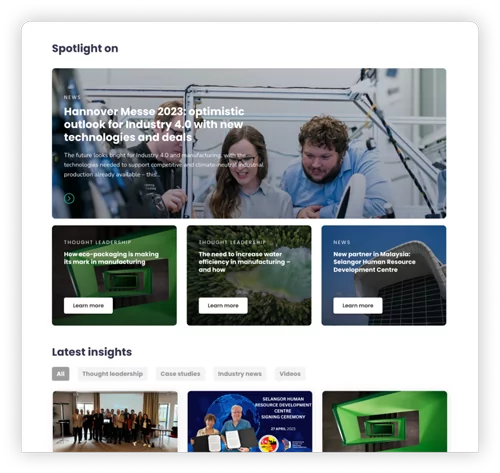Industry 4.0 has revolutionised the manufacturing industry in recent years. Today’s digitally enhanced factories have leveraged smart technologies like artificial intelligence, data analytics and the cloud to optimise production and reduce waste, leading to better productivity than before. These technologies have provided numerous benefits – from 30% to 50% reductions in machine downtime to 85% more accurate forecasting.
With this constant improvement, Industry 4.0 is gradually progressing towards Industry 5.0. But what are the key differences between these stages of industrialisation and how should business leaders prepare for the next phase in manufacturing modernisation?
The Fifth Industrial Revolution
Industry 5.0 isn’t really a new developmental stage in industrialisation. Instead, it should be viewed as an add-on to Industry 4.0, building upon the groundwork laid by these smart technologies. While the focus of Industry 4.0 was connectivity, digitalisation and automation, Industry 5.0 highlights the importance of human-robot collaboration and the relationship between man and machine, or ‘cobots’.
According to the European Commission, Industry 5.0 “places the well-being of the worker at the centre of the production process and uses new technologies to provide prosperity beyond jobs and growth while respecting the production limits of the planet”. This means a greater emphasis on the human role in the modernised manufacturing process rather than relying solely on machine automation, while still respecting the world’s environmental needs.
We have already started to see this in the electronics sector as humans oversee the more intricate work carried out by cobots – the cognitive aspects of the task are managed by the human while the parts that require repetition and consistency are handled by cobots. This leads to greater efficiency while ensuring sustainable production processes. Car manufacturers like Audi have also demonstrated the importance of human-robot interaction from as early as 2019, highlighting usefulness of collaboration between robots and humans.
In essence, the three central pillars of Industry 5.0 are: human-centric, sustainable and resilient. This requires a strategy that ensures talents and diversity are promoted, agility and adaptability are prioritised, and the needs of the people and the planet are balanced.
How will Industry 5.0 drive sustainability?
Sustainability has been in the spotlight across industries globally, and it’s an essential part of Industry 5.0. With sustainable industrialisation being one of the key goals in the UN’s 2030 Agenda for Sustainable Development, embracing a strategy that works towards better environmental, social and governance (ESG) policies will lead to increased funding from the UN. In turn, this will prompt greater innovation and encourage companies to reinforce their sustainability plans.
This means Industry 5.0 could address both the environmental and social aspects of ESG by driving widespread ‘greening’ of the industry while encouraging innovation and creating more opportunities for manufacturers and people through advancing cobot use and relationships.
What should business leaders consider in relation to Industry 5.0?
Industry 5.0 has a promising future. Although it is still a relatively new concept, manufacturing businesses must pay more attention to this next phase of industrialisation, with sustainability taking centre stage.
Developing effective synergy between humans and machines in Industry 5.0 is critical for both business success and sustainability. This collaboration will enhance efficiency and provide new opportunities for people, mitigating the potential socioeconomic impacts of the perception that machines are replacing humans. By gradually transitioning Industry 4.0 objectives away from pure computing and process automation towards more human-robot collaboration, business leaders can make progress towards their productivity targets while fulfilling their ESG goals and aligning their strategy with the three central pillars of Industry 5.0.
Learn more about Industry 4.0, and the work that we’ve been doing to help global manufacturers transform to achieve better outcomes for all here.







